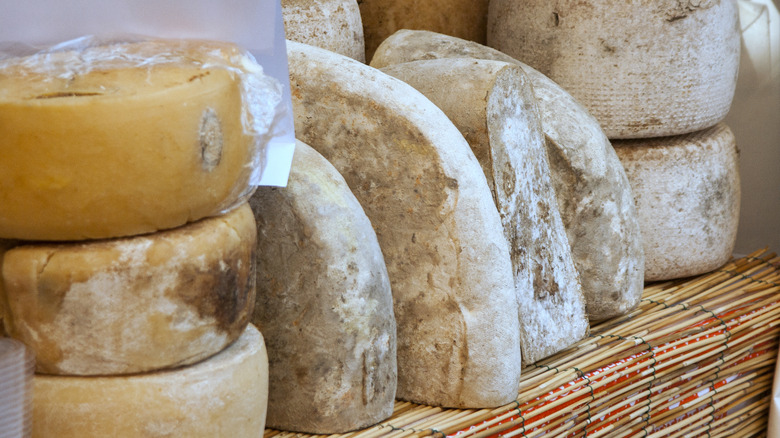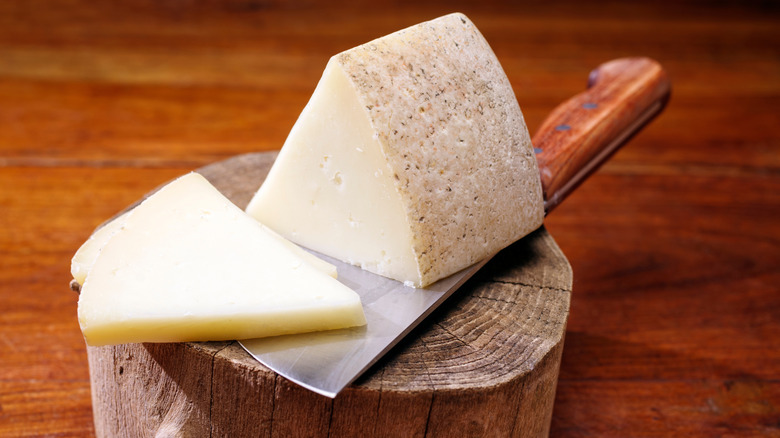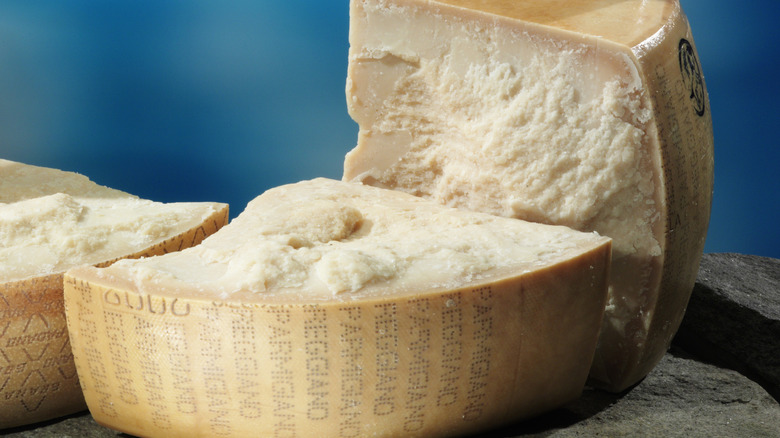Pecorino Vs Parmesan Cheese: What's The Difference?
Pecorino and Parmesan cheeses definitely have some similarities. Both are hard cheeses that hail from Italy, and you'll often find them on pasta dishes — although that's not the only place you might encounter them. However, treating these strongly flavored dairy products as interchangeable might be a mistake, as there are some key differences between them.
The two cheeses have different flavors and intensities and are produced in different ways using different types of milk. There's some debate over whether you can substitute them for each other in a recipe. A common verdict tends to be that you can switch them out for each other if you're in a bind, although it's generally better to use whichever cheese a recipe dictates. It also depends on the recipe. For example, when it comes to dishes like cacio e pepe pasta, there are sometimes strong opinions that you should strictly use pecorino. If you make that swap, use about ⅓ less pecorino than Parmesan, as it's saltier and may overpower things if you do a 1:1 substitution.
What to know about pecorino
Pecorino is a hard sheep's milk cheese, and its name comes from the Italian word for sheep. There are a few different types, but the most common one is pecorino Romano, which is not to be confused with Romano cheese. However, it's not drastically different; both are hard cheeses, but a soft, ricotta-like pecorino also exists. Sheep's milk contains more fat, giving it a grassy, tangy, and earthy flavor compared to cow milk cheeses. It's typically a white to pale yellow color compared to the more full-bodied yellow shade of Parmesan.
Pecorino is regarded as more intense and punchy in flavor than Parmesan, even though it's usually aged for less time — from a few months up to a year, compared to at least one year (and often more) for Parmesan. The longer it's aged, the more intense it will be, especially past the eight-month mark, when it becomes more crumbly and smoky. The younger version can have light, spicy notes to it. For serving, pecorino is often grated – its rather intense flavor means that you won't be overwhelmed if it's grated.
Because pecorino originates from outside Rome, it's a great addition to classic Roman pastas like carbonara, cacio e pepe, and Amatriciana. It generally works well with pasta. It can also be used in pesto, atop salads, or in a mix of cheese, say, for a gratin.
The important details of parmesan
Parmesan – called Parmigiano-Reggiano if it's the real deal from the Parma region in northern Italy — is made from cow's milk, not the sheep milk of pecorino. It was first made in the 13th century, making it a newer creation than pecorino, which dates back to ancient Rome.
Flavor-wise, it's not as salty as pecorino, and has more umami to it, as well as nutty and even sweet notes. It's aged for at least one year (compared to pecorino, which maxes out at one year of aging), but this can extend to over three years. Its texture will get crumblier and grainier the longer it's aged, and the flavor will intensify. That means you'll more likely use a Parmesan aged 12 to 24 months as opposed to one aged 30+ months. In terms of color, Parmesan is more of a solid yellow than whiter pecorino. It can even show hints of orange, with a rind that's somewhat darker than the rest of the cheese.
Unsurprisingly, Parmesan works well in dishes like Bobby Flay's chicken parmigiana. But it's very versatile, working well over a range of pasta, in salads (where it can be shaved into small strips), or even on cheese boards. Its distinct taste, which is a bit less pungent than pecorino, means it goes well with stews or recipes with a range of ingredients, where it will integrate well without overpowering other flavors. And, it's easier than you think to Parmesan-crust a steak.


